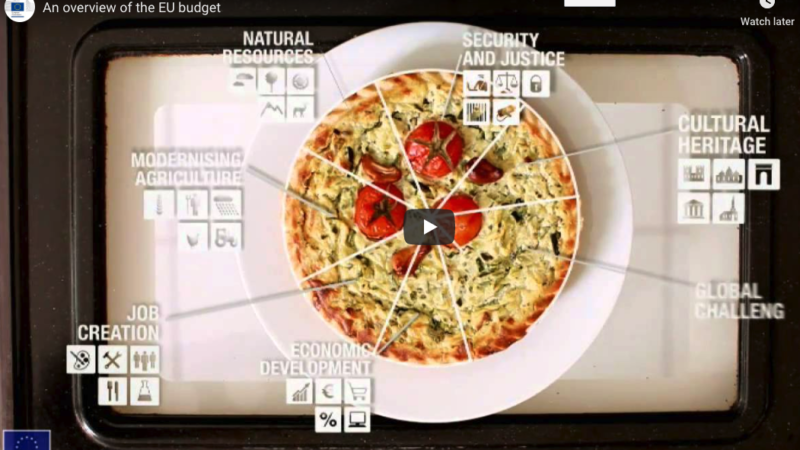An overview of the EU Budget (go on, give them some Youtube views)

The European Commission has put together the smart video above about the EU budget. Clearly professionally filmed and produced, I wonder whether it will it will convince anyone about the merits of the budget? Yes, OK, it’s 1% of EU GNI, that’s all very well. It’s decided in a transparent way. Good. But the problem is what the money is spent on (and the fact this this is so incredibly slow to change) – that’s down to administrative complexity.
Also isn’t a young woman doing some cooking a rather gender specific way to approach this?
Anyway, I am glad at least that the Commission is trying in part to set out how the budget works and using a reasonable video to do this. The video has only 1500 views at the time of writing – it should get more than that at least.
[UPDATE]
@erikwesselius on Twitter has pointed out this video – more balanced, but probably with a lower budget to film it.
http://www.youtube.com/watch?v=Sq_E4-lMowg
Nice video… But “http://ec.europa.eu/contracts_grants/beneficiaries_en.htm”??
… Couldn’t they have set up an alias for promotional purposes that was remotely memorable? 🙂
It possibly says more about you guys that you see heating up a shop-bought quiche as “cooking” than anything else.
But fundamentally this message is next to useless. Those who are broadly supportive of the Union won’t learn from it, those against it will not be swayed. They object to the fact of the EU’s spending any money, not the amount: whether it’s 126 or 130 billion euros is of little consequence to them. The 1% of GNI figure sounds great to those in favour, but it just doesn’t work; it’s too abstract. Nor do comparisons such as “more people work for Birmingham city council than for the Commission” – that may be so but how many bins does the Commission empty each week? You need to compare like for like and be much more sophisticated. And get out and defend (or change if necessary) the individual budget lines which are held up to ridicule by eurosceptics.
The only way the Union can win arguments on the budget is to demonstrate that if the EU didn’t spend the money at that level, the sum of member state spending in those areas would be significantly higher. And that’s a very difficult proposition, in particular against a “market-enthusiast” position which argues that neither the EU nor lower levels of government should be engaged in such activities.
I’m sorry, but I don’t find it either reasonable or well done.
The clip claims transparency but demonstrates the opposite. The small amount of hard information is repeatedly shown in white text on white backgrounds. Is that supposed to symbolize transparency? At the end, a link (to ‘complete’ information) is displayed, but much too briefly to note or memorize, and there’s no Flash layer to make it clickable.
And what’s the intended distribution channel? I don’t mind about the cost as such but I would like to see figures for the cost per view, predicted and achieved.
For a different approach, see the excellent graphic on the EU budget process published on the European Parliament’s website last week.
Wouldn’t that be gender cliché – only grumpy fat man are doing politics and care for budget questions…?! 😉
On the woman cooking thing – OK, maybe not. But typical they choose an attractive woman to illustrate the video. Why not go for a grumpy, fat, unhealthy man? Barroso for example?
Well-done video indeed. Although I’m not convinced that it is really convincing for anybody who a) doesn’t know how the EU works or b) doesn’t like how the EU works.
It would still be interesting to know which communications agency has produced it and for what prize… 😉
And talking about transparency of the budget and about beneficiaries transparency: We still lack good open and machine readable data on actual spending of EU funds and money (so far we just have some open data on EU Commission contracts, not on the real money flows), especially the money handled by the member states. The lack of this data makes it pretty hard to control whether the money is always well-spent.
So the process may be comparatively open, but I personally doubt that it is really possible to assess the real impact of a lot of the money spent (as the Court of Auditors has noted in a recent Special Report).
PS: However, a woman cooking some food for herself isn’t really a gender cliché.